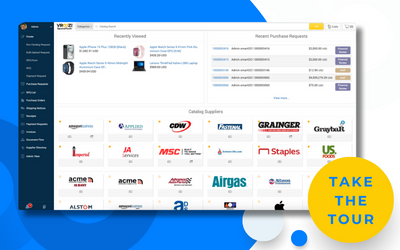Using low-code platforms to supplement your procure-to-pay solution and get more spend under management

- Low-code tools to build user interfaces and apps
- Low-code tools to integrate and transform data
The first type is app maker software, used to build user interfaces that interact with your business data. This type includes software such as Google Appsheet, AWS Honeycode and Microsoft Power Apps, plus a whole host of smaller competitors such as Coda, Appian and Unqork.
The second type is integration software, used to integrate, transform and report on business data. Each of the big cloud providers have their own solutions:
- Google Dataprep
- AWS Appflow
- Microsoft Power Automate
And there are a large number of smaller competitors tackling different aspects of integration:
- Moving large amounts of data around: Hevo and Matillion.
- Connecting applications: Stitch, Kumologica, Cloudwright, Zapier, Boomi, Snaplogic, Talend, Informatica, Parabola, Celigao, and Mulesoft
- Integration as a service: OpenText, Pega, and Managed Functions
Integration software is more relevant to procurement operations than app maker software, so we’ll focus on that type of software for the remainder of this article.
So, why is integration software a hot category now?
Integration is simply the act of combining one thing with another thing to create a whole. It’s hot now because the explosion of different enterprise apps has created integration opportunities everywhere — and procurement operations are no exception.
Procure-to-pay (P2P) software puts in place a slick process to buy the things your organization needs at the right time from the right supplier at the right price. It integrates your ERP/financial system with a network of suppliers and allows transactions to flow safely between you and your trading partners. Everything fits together like a well-tiled wall.
Photo by Danny Howe on Unsplash
That’s the dream.
But the reality is that the world is a beautiful but complex medley of elements. Instead of a well-tiled wall, the real world is better represented by the mosaic below. Your systems and your supplier’s systems still fit together, but there’s some complexity and some beauty in how it forms a cohesive whole.
The mosaic below is a better representation of the real world. There are large tiles that represent larger cohesive systems like your ERP system and your procure-to-pay system, but there are also quite a few smaller tiles that represent suppliers that don’t fit neatly into your supplier network, such as some local suppliers, government regulators and utilities.
Photo by Victoria Strukovskaya on Unsplash
When you are looking at what tiles to connect directly to your procure-to-pay solution, you’ll find it worthwhile connecting together the big tiles, but as the tiles get smaller, it becomes harder to justify the business case. And, good luck connecting your procure-to-pay system to that shell!
The trading partners and agencies that don’t fit neatly into your procurement processes are less important than your key partners, but failing to integrate them into your procurement landscape leads to a perception that your systems are not working seamlessly.
To solve this problem, you can get out your spade, pry out these pieces and replace them with larger tiles — but that is time-consuming, low-value work that may never deliver a positive return on investment. Alternatively, you can take a different approach and integrate with these organizations using low-code software.
For example, imagine you’re the Head of Finance for a national franchise company with a few hundred franchisees. You pay utilities bills for these franchisees centrally and have a slick process to validate the invoices, accurately assign account coding and import the data into your ERP system.
When the procurement team asks you to put this spend into the procure-to-pay system, you are reluctant to move from your current slick process. To comply with the procurement team’s request, you have a couple of alternatives:
- Set up contracts or blanket POs for each of these suppliers and submit invoices against each of these contracts. But setting up and managing hundreds of contracts will take a lot of time and, from a risk or spend reduction viewpoint, not deliver much in return.
- Put these in as non-PO invoices, but then you have to approve and code each invoice separately.
Neither solution is ideal, and your team would be reluctant to move from a process that is working well to a process that works less well.
Now, imagine you are the Head of Procurement for this national franchise company. With a low-code solution, instead of asking the finance team to move away from their current slick process for these low-risk vendors you could build a tool that takes the output from the finance team and automatically creates an invoice in your procure-to-pay system and a matching PO and goods receipt. The finance team continues to do what they’ve always done, and you get all of that spend in your procure-to-pay system where it can be reported on along with the rest of your company’s spend.
More coverage: See rankings of procure-to-pay vendors in Spend Matters’ SolutionMap
This allows you to focus on your high-impact, higher-risk trading partners knowing that you are transacting efficiently with your low-impact, lower-risk trading partners. You can think of this as mortar that surrounds your lower-risk trading partners and ensures that they fit in well with your overall systems and processes.
Taking this a step further, if customers of procure-to-pay software companies are using low-code solutions to get some lower-risk spend into their procure-to-pay systems, why don’t the procure-to-pay software companies offer this to their customers? That’s exactly what some P2P software companies have begun to do.
For example, P2P provider Vroozi partners with us on low-code integration services.
“Connecting in the cloud and to the cloud is critical in the modern procurement space,” Vroozi CEO Joe Fox says. “Most P2P players connect directly to all the major finance and ERP systems, but it’s impossible to cover every system out there. Working with connectivity partners is a game changer for us and our clients.”
Getting started with low-code is easy. Most of the low-code platforms have free trials available. With the abundance of low-code solutions out there, you should be able to get all your spend into your P2P platform.
You can ask us more about integration issues. And you can view a sortable list of low-code applications here: http://www.managedfunctions.com/pirate



